Experimental Study on an Innovative Double-Limb-Thin-Wall Bridge Pier with Longitudinal Replaceable Connecting Beams
Abstract
1. Introduction
2. Design Concept and Failure Modes of the Innovative DLTW-RSCBs
3. Experimental Program
3.1. Specimen Design
3.2. Material Properties
3.3. Test Setup and Loading Protocol
3.4. Arrangement of the Measurement Points
4. Test Observation and Failure Modes
4.1. DLTW-NB Specimen
4.2. DLTW-RCCBs and DLTW-RSCBs Specimens
5. Test Results and Analysis
5.1. Hysteretic Curves
5.2. Skeleton Curves and Ductility
5.3. Hysteretic Performance of the Replaceable Steel Connecting Beam (RSCB)
5.4. Cumulative Hysteretic Dissipated Energy
5.5. Residual Drift Ratio
6. Discussions
6.1. Comparisons of Damage Development
- (1)
- Elastic stage. The CBs yielded first, prior to the limb-wall columns, to protect the main structure (columns). As a result, the DLTW-RCCBs and DLTW-RSCBs specimens demonstrated larger elastic deformation than the DLTW-NBs specimen, while the increase in the amplitude of the DLTW-RSCBs specimen was larger. Therefore, the use of CBs improves the seismic resistance of the piers under small earthquakes (i.e., lower damage at the same deformation).
- (2a)
- Rapidly repairable stage. The crack widths of the limb-wall column bottom increased with increasing loading displacement and reached 1 mm [43] (i.e., entered a moderate damage state) at the drift ratio of 0.7% for the DLTW-NBs specimen. On the other hand, the DLTW-RCCBs and DLTW-RSCBs specimens just exceed the yield point and were still at the slight damage state. The crack widths of the DLTW-NBs specimen reached 2 mm [43], and repair was difficult (serious damage) at 1.4% drift ratio, while the DLTW-RCCBs and DLTW-RSCBs specimens were still in a moderate damage state and could be conveniently repaired.
- (2b)
- Costly repairable stage. The RCCBs were severely destroyed, and the DLTW-RCCBs specimen entered a serious damage state at the drift ratio of 2.1%. On the other hand, the RSCBs could still be replaced despite the damage deformation when the limb-wall columns began to enter serious damage at 2.04% drift ratio, before which the limb-wall columns could still be repaired with great effort. Therefore, the use of connecting beams (CBs) can reduce the damage of piers before the failure of connecting beams (CBs), and the RSCBs can be replaced more conveniently than the RCCBs after damage failure.
- (3)
- Non-collapse stage. The RCCBs were severely damaged at the initial stage of serious damage (drift ratio of 2.1%) for the DLTW-RCCBs specimen, while the damage to the RSCBs gradually intensified with increasing loading displacement after the drift ratio of 2.1%. The damage of the limb-wall columns for the DLTW-RCCBs and DLTW-RSCBs specimens gradually increased with the damage development of the connecting beams (CBs). Additionally, their failure modes after the failure of CBs were similar to those of the DLTW-NBs specimens, as these three specimens have the same structure type. The buckling and low-cycle fatigue fracture of the longitudinal bars at the column bottom finally caused the failure of all three bridge piers, i.e., collapse. As the CBs already completely failed, and the failure of columns controls the final damage of the bridge pier, the use of the CBs does not improve the ultimate displacement of DLTW piers.
6.2. Repairability of the Replaceable RSCBs
7. Conclusions
- (1)
- The use of the connecting beams (CBs) can improve the bearing capacity of the DLTW piers, of which the DLTW-RCCBs and DLTW-RSCBs specimens are 3.2% and 21.6% larger than the DLTW-NBs specimen, respectively. The DLTW piers with CBs have larger yield displacement and elastic deformation than the DLTW-NBs specimen, of which the increased amplitude of the DLTW-RSCBs specimen is larger than that of the DLTW-RCCBs. This is because steel/reinforcement of the CBs yields earlier than limb-wall columns and then dissipates seismic energy and protects the main structure (columns) from plastic damage. The ultimate displacements of the DLTW-RCCBs and DLTW-RSCBs specimens are 14% and 6.8% lower than that of the DLTW-NBs specimen, respectively. The decreased amplitudes of the displacement ductility are larger than the ultimate displacement because of the increase in yield displacement.
- (2)
- The cumulative dissipated energies of the DLTW-RCCBs and DLTW-RSCBs specimens are lower than that of the DLTW-NBs specimen at the initial loading stage because the use of CBs enhances the yield deformation and reduces the plastic deformation of DLTW piers. However, due to the excellent energy dissipation capacity of RSCBs, the cumulative dissipated energy of the DLTW-RSCBs gradually surpassed that of the DLTW-NBs with increasing loading displacement because the large plastic deformation of the RSCBs can facilitate energy dissipation to the DLTW pier. In contrast, the DLTW-RCCBs specimen has a lower energy dissipation capacity than the DLTW-NBs specimen during the whole loading process due to the poor energy dissipation capacity of RCCBs.
- (3)
- Due to the protection of the CBs, the damage degrees to the DLTW-RCCBs and DLTW-RSCBs specimens are lower than that of the DLTW-NBs specimen at the same drift ratio before the failure of the CBs. For example, the DLTW-NBs entered moderate damage and serious damage at drift ratios of 0.7% and 1.4%, respectively, while the DLTW-RCCBs and DLTW-RSCBs specimens were still at slight and moderate damage, respectively, at the corresponding drift ratios. Furthermore, the DLTW-RCCBs and DLTW-RSCBs specimens have lower residual drift ratios than the DLTW-RSCBs at slight and moderate damage states and are easier to repair. However, the use of CBs cannot reduce the damage of DLTW piers at the failure stage, as the CBs have already been completely destroyed, and the failure of columns controls the final damage of the DLTW piers. As a result, the residual drift ratio of the DLTW-RSCBs specimen is also close to that of the DLTW-NBs specimen at the failure point.
- (4)
- The damage of the connecting beams (CBs) for the DLTW-RSCBs specimen is mainly concentrated at the energy dissipation segments and can be replaced approximately 1 h after damage failure. Compared with conventional DLTW-NBs and DLTW-RCCBs, the proposed innovative DLTW-RSCBs demonstrate better seismic performance, such as larger lateral bearing capacity and energy-dissipation capacity, lower residual drift ratio, and seismic damage before severe damage states, as well as better repairability. Therefore, the proposed DLTW-RSCBs can improve the longitudinal seismic resistance of rigid-frame bridges, and they can reduce the repair costs of bridge structures under earthquake loading, which are valuable for the sustainability during their whole service lives.
- (5)
- Although the use of RSCBs can improve seismic performance and reduce the damage development of DLTW piers to some extent, the main structures (limb-wall columns) of the DLTW piers still unavoidably endure serious damage and are difficult to repair under strong earthquakes. Therefore, further work should be conducted to reduce residual deformation and improve the seismic resilience of DLTW piers under moderate and strong earthquakes. A reasonable combination of rocking and RSCBs in DLTW piers may be a good choice.
Author Contributions
Funding
Institutional Review Board Statement
Informed Consent Statement
Data Availability Statement
Acknowledgments
Conflicts of Interest
Abbreviations
| DLTW | Double-Limb-Thin-Wall |
| RSCBs | Replaceable Steel Connecting Beams |
| DLTW-RSCBs | DLTW Pier With RSCBs |
| RC | Reinforced Concrete |
| DLTW-RCCBs | DLTW Pier With RC Connecting Beams |
| CBs | Connecting Beams |
| BRBs | Buckling-Restrained Braces |
| VDB | Viscous Damper Braces |
| PBSCs | Piston-Based Self-Centering Braces |
| DRCLB | Dual-Replaceable Composite Link Beam |
| SS | Steel Sleeve |
| GCMD | Grouted Corrugated-Metal Duct |
| SCED | Self-Centering Energy-Dissipation |
| SC-BRB | Self-Centering BRB |
| SCSF | Self-Centering Slip Friction |
| DLTW-NBs | DLTW Pier With No Beams |
Nomenclature
| Vcs | Deign shear capacity |
| ρsv | Reinforcement ratio of transverse reinforcement |
| fsv | Yield strength of transverse reinforcement |
| fcu,k | Cubic compressive strength of concrete |
| B | Width of the cross section |
| h0 | Height of the cross section |
| P | Axial load |
| Vlp | Plastic shear capacity of the energy-dissipation segment |
| Mlp | Plastic bending capacity of the energy-dissipation segment |
| e | Length of the energy-dissipation segment |
| fy | Yield strength of steel |
| Aw | Shear section area of the steel connecting beam |
| W | Moment resistance of the steel connecting beam |
| Mbp | Plastic shear capacity of the rigid beam segment |
| Vbp | Plastic bending capacity of the rigid beam segment |
| l | Clear span of the RSCB |
| Ω | The overstrength factor |
| εi | Bending strains of the Section A or B |
| yi,j | Distance between the two strain gauges |
| ϕ | Curvature of section A or B |
| E | Elastic modulus |
| I | Moment of inertia |
| lAB | Distance between two rigid sections |
| M | Bending moment |
| V | Shearing force |
| θ | Rotations of the two end plates |
| ϕr | Rotations of two sections of the two cross displacement transducers |
| Δi | Displacement data, i = 1,2 |
| li | Horizontal distance between the two cross displacement transducers |
| hr | Web height of the rigid segment |
| Δy | Yield displacement |
| Fm | Maximum bearing capacity |
| Δu | Ultimate displacement |
| μΔ | Displacement ductility |
| Δres± | Residual drift ratio |
References
- Peng, Y.; Zhang, Z. Development of a novel type of open-web continuous reinforced-concrete rigid-frame bridge. J. Bridge Eng. 2020, 25, 05020005. [Google Scholar] [CrossRef]
- Wang, H.; Xie, C.; Liu, D.; Qin, S. Continuous reinforced concrete rigid-frame bridges in China. Pract. Period. Struct. Des. Constr. 2019, 24, 05019002. [Google Scholar] [CrossRef]
- Yuan, W.; Hu, B.; Fan, L. Seismic capacity and assessment of column piers. J. Tongji Univ. Nat. Sci. 1996, 21, 601. (In Chinese) [Google Scholar]
- Billah, A.H.M.M.; Alam, M.S. Seismic performance evaluation of multi-column bridge bents retrofitted with different alternatives using incremental dynamic analysis. Eng. Struct. 2014, 62, 105–117. [Google Scholar] [CrossRef]
- Wu, R.Y.; Pantelides, C.P. Seismic evaluation of repaired multi-column bridge bent using static and dynamic analysis. Constr. Build. Mater. 2019, 208, 792–807. [Google Scholar] [CrossRef]
- Pantelides, C.P.; Ward, J.P.; Reaveley, L.D. Behavior of R/C bridge bent with grade beam retrofit under simulated earthquake loads. Earthq. Spectra 2004, 20, 91–118. [Google Scholar] [CrossRef]
- Aloisio, A.; Pelliciari, M.; Alaggio, R.; Nuti, C.; Fragiacomo, M.; Briseghella, B. Structural robustness of an RC pier under repeated earthquakes. Proc. Inst. Civ. Eng.-Bridge Eng. 2022, 1–8. [Google Scholar] [CrossRef]
- Paolacci, F.; Giannini, R. An experimental and numerical investigation on the cyclic response of a portal frame pier belonging to an old reinforced concrete viaduct. Earthq. Eng. Struct. Dyn. 2012, 41, 1109–1127. [Google Scholar] [CrossRef]
- Xia, Z.; Ge, J.; Lin, Y.; Qiu, F. Shake table study on precast segmental concrete double-column piers. Earthq. Eng. Eng. Vib. 2020, 19, 705–723. [Google Scholar]
- Upadhyay, A.; Pantelides, C.P. Fragility-informed seismic design of multi-column bridge bents with post-tensioned concrete columns for accelerated bridge construction. Eng. Struct. 2022, 269, 114807. [Google Scholar] [CrossRef]
- El-Bahey, S. Analytical Development and Experimental Validation of a Structural-Fuse Bridge Pier Concept; State University of New York at Buffalo: Buffalo, NY, USA, 2010. [Google Scholar]
- El-Bahey, S.; Bruneau, M. Buckling restrained braces as structural fuses for the seismic retrofit of reinforced concrete bridge bents. Eng. Struct. 2011, 33, 1052–1061. [Google Scholar] [CrossRef]
- Chen, X.; Li, C. Seismic assessment of tall pier bridges with double-column bents retrofitted with buckling restrained braces subjected to near-fault motions. Eng. Struct. 2021, 226, 111390. [Google Scholar] [CrossRef]
- El-Bahey, S.; Bruneau, M. Bridge piers with structural fuses and bi-steel columns. I: Experimental testing. J. Bridge Eng. 2012, 17, 25–35. [Google Scholar] [CrossRef]
- El-Bahey, S.; Bruneau, M. Bridge piers with structural fuses and bi-steel columns. II: Analytical investigation. J. Bridge Eng. 2012, 17, 36–46. [Google Scholar] [CrossRef]
- Wang, Y.; Ibarra, L.; Pantelides, C. Seismic retrofit of a three-span RC bridge with buckling-restrained braces. J. Bridge Eng. 2016, 21, 04016073. [Google Scholar] [CrossRef]
- Bazaez, R.; Dusicka, P. Design implementation of buckling restrained braces for seismic retrofitting of reinforced concrete multi-column bridge bents. In Proceedings of the Structures Congress, Portland, OR, USA, 23–25 April 2015; Volume 2015, pp. 485–496. [Google Scholar]
- Bazaez, R.; Dusicka, P. Cyclic behavior of reinforced concrete bridge bent retrofitted with buckling restrained braces. Eng. Struct. 2016, 119, 34–48. [Google Scholar] [CrossRef]
- Wei, X.; Bruneau, M. Case study on applications of structural fuses in bridge bents. J. Bridge Eng. 2016, 21, 05016004. [Google Scholar] [CrossRef]
- Xie, W.; Sun, L.; Wei, J. Experimental study on seismic performance of bridge piers with structural fuses and its application. China J. Highw. Transp. 2014, 27, 59. [Google Scholar]
- Dong, H.; Du, X.; Han, Q.; Bi, K.; Hao, H. Hysteretic performance of RC double-column bridge piers with self-centering buckling-restrained braces. Bull. Earthq. Eng. 2019, 17, 3255–3281. [Google Scholar] [CrossRef]
- Monteiro, A.; Arede, A.; Vila-Pouca, N.; Peixoto, A.; Delgado, R. Experimental evaluation of the cyclic behavior of a double-column bridge pier with a short span coupling beam. In Proceedings of the 15 World Conference on Earthquake Engineering, Lisbon, Portugal, 24–28 September 2012; Volume 1, pp. 2–8. [Google Scholar]
- Monteiro, A.; Arêde, A.; Pouca, N.V. Seismic behavior of coupled column bridge RC piers: Experimental campaign. Eng. Struct. 2017, 132, 399–412. [Google Scholar] [CrossRef]
- Xu, L.; Lu, X.; Zou, Q.; Ye, L.; Di, J. Mechanical behavior of a double-column self-centering pier fused with shear links. Appl. Sci. 2019, 9, 2497. [Google Scholar] [CrossRef]
- Xiang, N.; Alam, M.S. Displacement-based seismic design of bridge bents retrofitted with various bracing devices and their seismic fragility assessment under near-fault and far-field ground motions. Soil Dyn. Earthq. Eng. 2019, 119, 75–90. [Google Scholar] [CrossRef]
- Zhong, J.; Zheng, X.; Wu, Q.; Jiang, L.; He, M.; Dang, X. Seismic fragility and resilience assessment of bridge columns with dual-replaceable composite link beam under near-fault GMs. Structures 2023, 47, 412–424. [Google Scholar] [CrossRef]
- Xia, X.; Zhang, X.; Wang, J. Shaking table test of a novel railway bridge pier with replaceable components. Eng. Struct. 2021, 232, 111808. [Google Scholar] [CrossRef]
- Zhang, X.; Xia, X.; Han, S. Quasi-static test of the lattice-type railway bridge pier with replaceable connection component. Structures 2022, 43, 635–644. [Google Scholar] [CrossRef]
- Xie, W.; Sun, L. Experimental and computational assessment of shear beams as earthquake resilient measure for double-column piers supported by pile-group. Eng. Struct. 2021, 242, 112509. [Google Scholar] [CrossRef]
- ElGawady, M.A.; Sha’lan, A. Seismic behavior of self-centering precast segmental bridge bents. J. Bridge Eng. 2010, 16, 328–339. [Google Scholar] [CrossRef]
- Thonstad, T.; Mantawy, I.M.; Stanton, J.F.; Eberhard, M.O.; Sanders, D.H. Shaking table performance of a new bridge system with pretensioned rocking columns. J. Bridge Eng. 2016, 21, 04015079. [Google Scholar] [CrossRef]
- Du, X.; Zhou, Y.; Han, Q.; Jia, Z. Shaking table tests of a single-span freestanding rocking bridge for seismic resilience and isolation. Adv. Struct. Eng. 2019, 22, 3222–3233. [Google Scholar] [CrossRef]
- Zhou, Y.; Han, Q.; Du, X.; Jia, Z. Shaking table tests of post-tensioned rocking bridge with double-column bents. J. Bridge Eng. 2019, 24, 04019080. [Google Scholar] [CrossRef]
- Cheng, C.T. Shaking table tests of a self-centering designed bridge substructure. Eng. Struct. 2008, 30, 3426–3433. [Google Scholar] [CrossRef]
- Han, Q.; Jia, Z.; Xu, K.; Zhou, Y.; Du, X. Hysteretic behavior investigation of self-centering double-column rocking piers for seismic resilience. Eng. Struct. 2019, 188, 218–232. [Google Scholar] [CrossRef]
- Zhou, Y.; Han, Q.; Du, X.; Zhang, J.; Cheng, S.; Chen, J. Additional viscous dampers for double-column rocking bridge system: Seismic response and overturning analysis. Soil Dyn. Earthq. Eng. 2021, 141, 106504. [Google Scholar] [CrossRef]
- Cheng, X.; Erochko, J.; Lau, D. Improving the seismic performance of existing bridge structures using self-centering dampers. In Proceedings of the 15th World Conference on Earthquake Engineering, Santiago, Chile, 9–13 January 2017. [Google Scholar]
- Cheng, X. Improving the Seismic Performance of Existing Bridge Structures Using Self-Centering Dampers. Doctoral Dissertation, Carleton University, Ottawa, ON, Canada, 2017. [Google Scholar]
- Dong, H.; Du, X.; Han, Q.; Hao, H.; Bi, K.; Wang, X. Performance of an innovative self-centering buckling restrained brace for mitigating seismic responses of bridge structures with double column piers. Eng. Struct. 2017, 148, 47–62. [Google Scholar] [CrossRef]
- Dong, H.; Du, X.; Han, Q.; Bi, K. Numerical Studies on the Seismic Performances of RC Two-Column Bent Bridges with Self-Centering Energy Dissipation Braces. J. Struct. Eng. 2020, 146, 04020038.1–04020038.16. [Google Scholar] [CrossRef]
- Xue, D.; Bi, K.; Dong, H.; Qin, H.; Han, Q.; Du, X. Development of a novel self-centering slip friction brace for enhancing the cyclic behaviors of RC double-column bridge bents. Eng. Struct. 2021, 232, 111838. [Google Scholar] [CrossRef]
- Wang, C.; Yin, C.; Zou, Y.; Ping, B.; Wu, X.; Liao, J.; Sun, M. Numerical Investigations on Seismic Behavior of Segmental Assembly of Concrete Filled Steel Tube Piers with External Replaceable Energy-Dissipating Links. Materials 2023, 16, 1122. [Google Scholar] [CrossRef]
- Hose, Y.D.; Seible, F. Performance Evaluation Database for Concrete Bridge Components and Systems under Simulated Seismic Loads; Pacific Earthquake Engineering Research Center, College of Engineering, University of California: Oakland, CA, USA, 1999. [Google Scholar]
- JTG 3362-2018; Specifications for Design of Highway Reinforced Concrete and Prestressed Concrete Bridges and Culverts. Ministry of Transport of the People’s Republic of China: Beijing, China, 2018. (In Chinese)
- ANSI/AISC 341-10; Seismic Provisions for Structural Steel Buildings. American Institute of Steel Construction: Chicago, IL, USA, 2010.
- GB/50011-2010; Code for Seismic Design of Buildings. China Architecture & Building Press: Beijing, China, 2010. (In Chinese)
- Ji, X.; Wang, Y.; Ma, Q.; Okazaki, T. Cyclic behavior of replaceable steel coupling beams. J. Struct. Eng. 2017, 143, 04016169. [Google Scholar] [CrossRef]
- Guan, Z.; Zhang, J.; Li, J. Multilevel performance classifications of tall RC bridge columns toward postearthquake rehabilitation requirements. J. Bridge Eng. 2017, 22, 04017080. [Google Scholar] [CrossRef]
- Applied Technology Council; Mid-America Earthquake Center; Multidisciplinary Center for Earthquake Engineering Research (US); Pacific Earthquake Engineering Research Center; National Earthquake Hazards Reduction Program (US). Interim Testing Protocols for Determining the Seismic Performance Characteristics of Structural and Nonstructural Components; Federal Emergency Management Agency: Washington, DC, USA, 2007. [Google Scholar]
- JGJ/T 101-2015; Specification for Seismic Test of Buildings. China Architecture & Building Press: Beijing, China, 2015; pp. 15–16. (In Chinese)
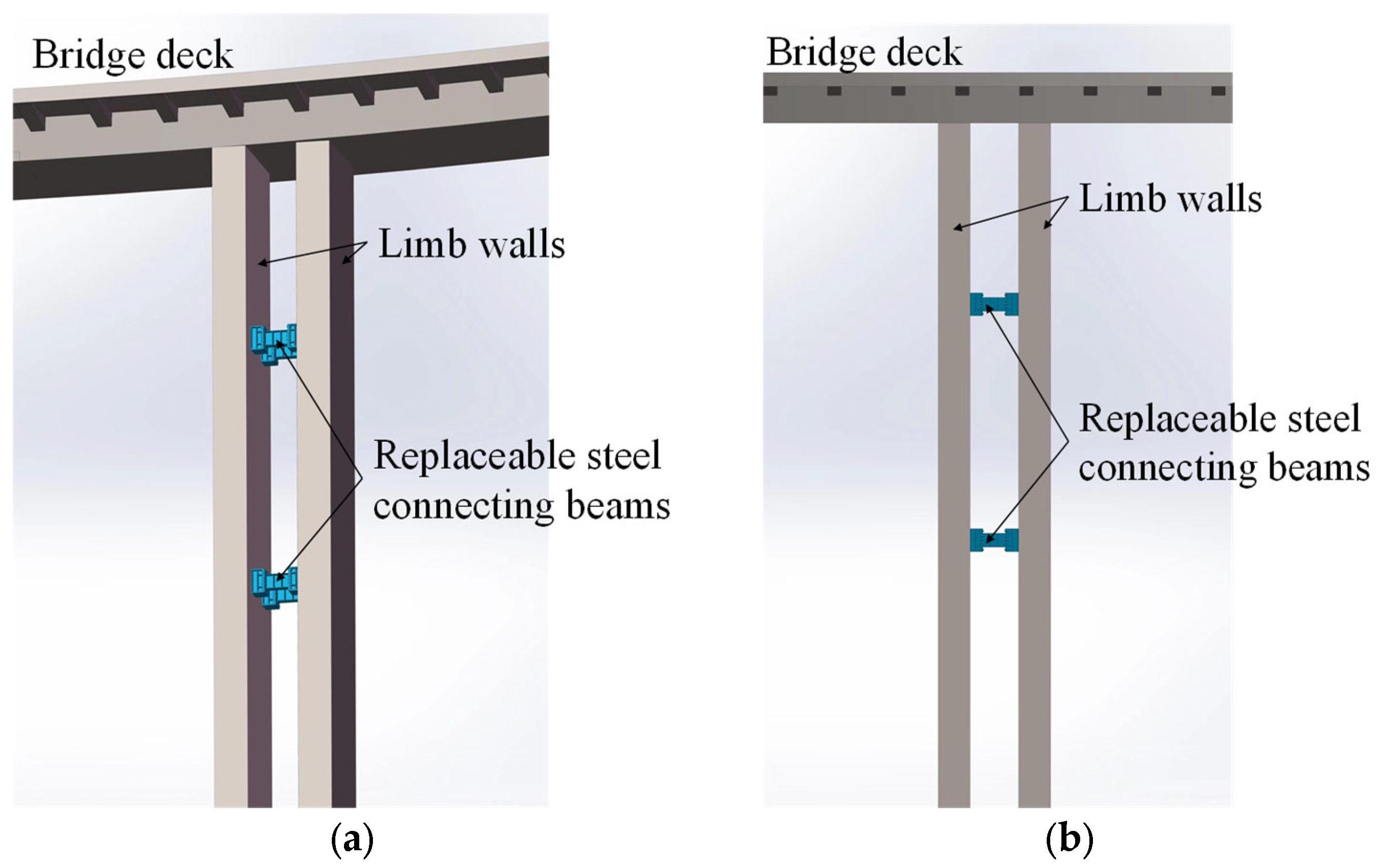



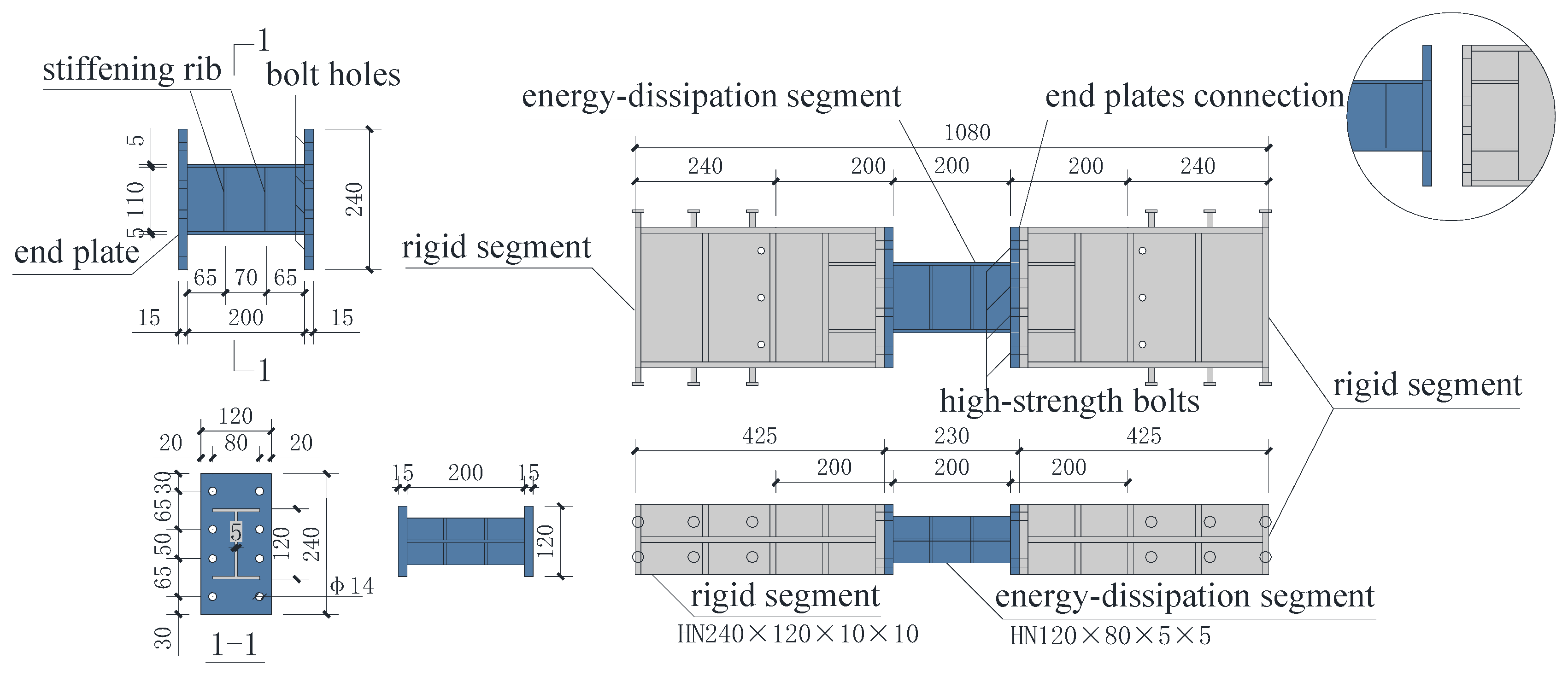
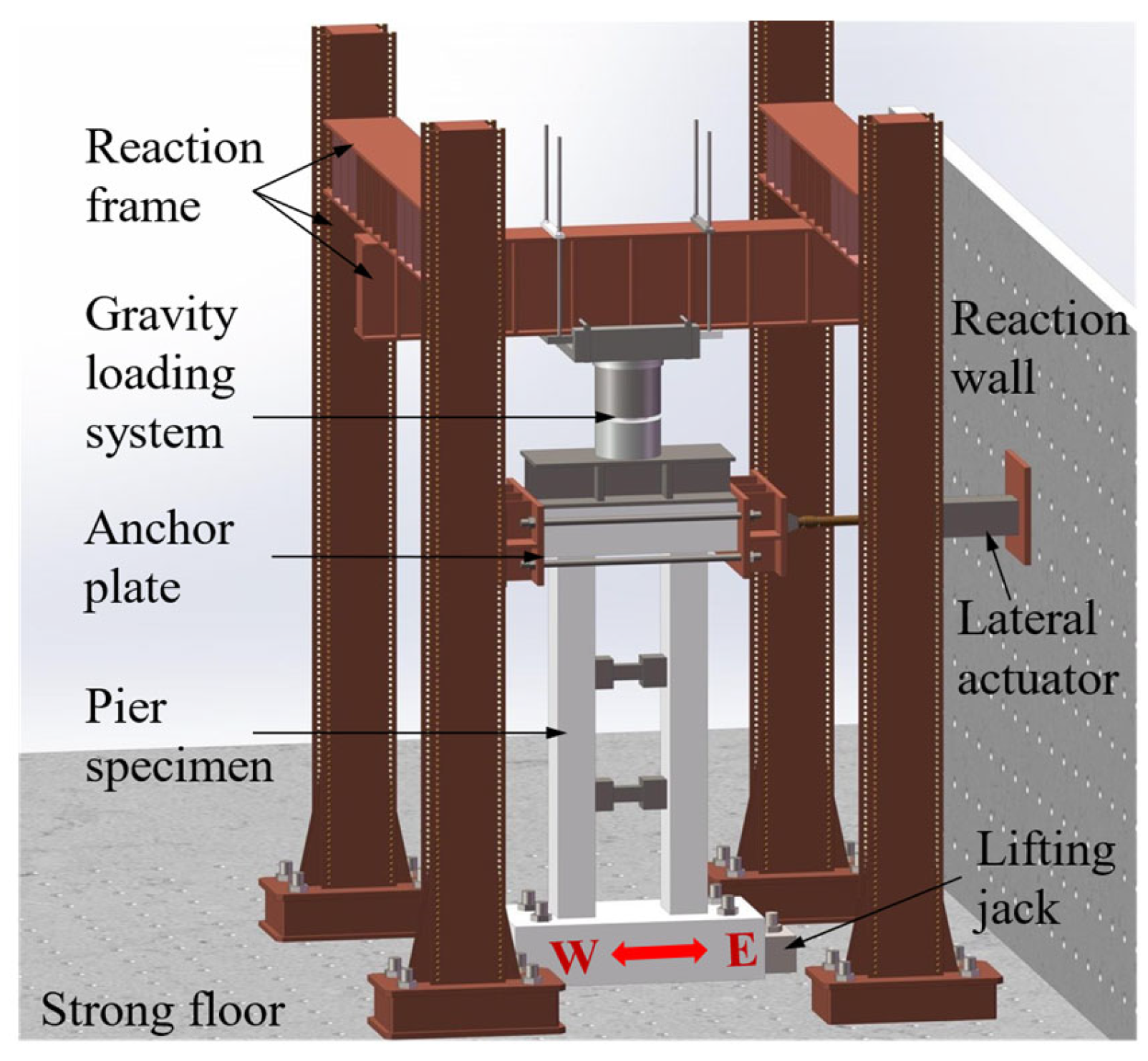
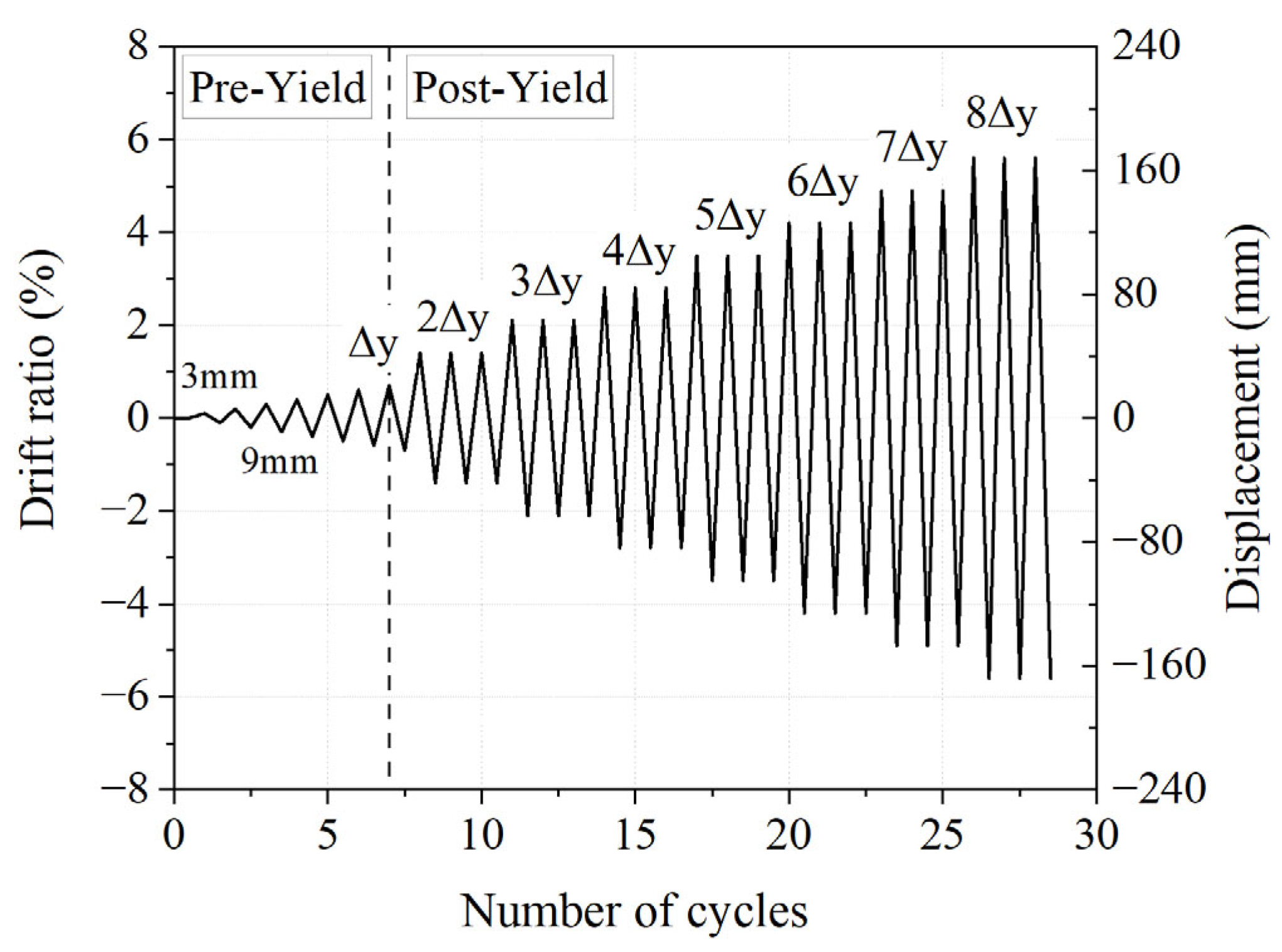

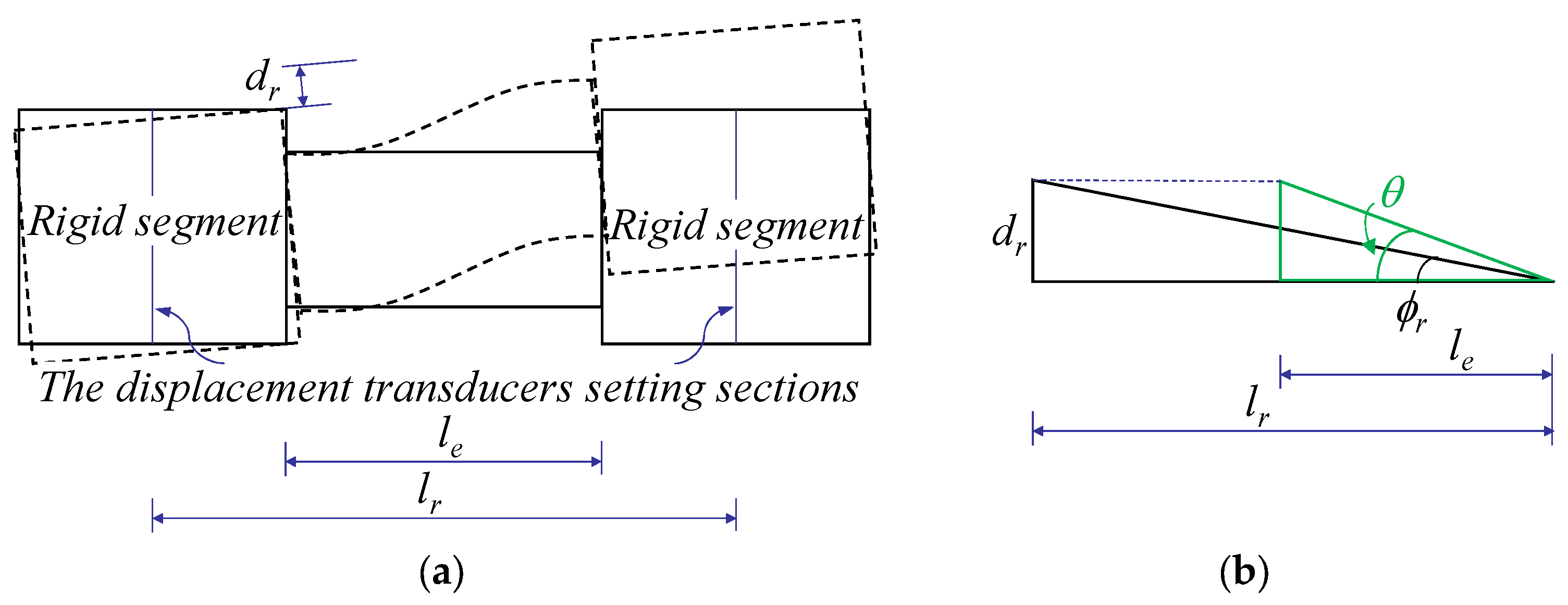
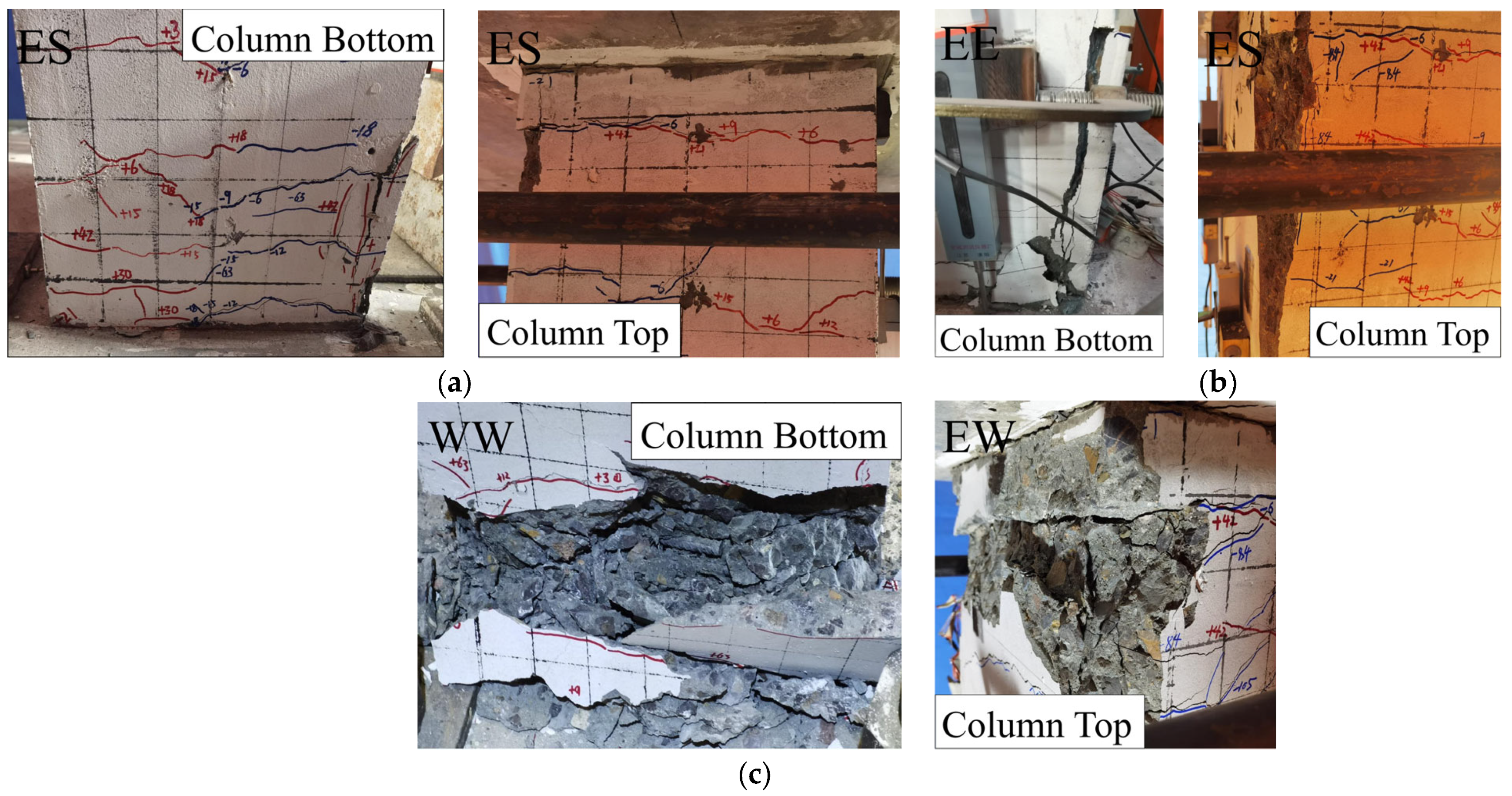
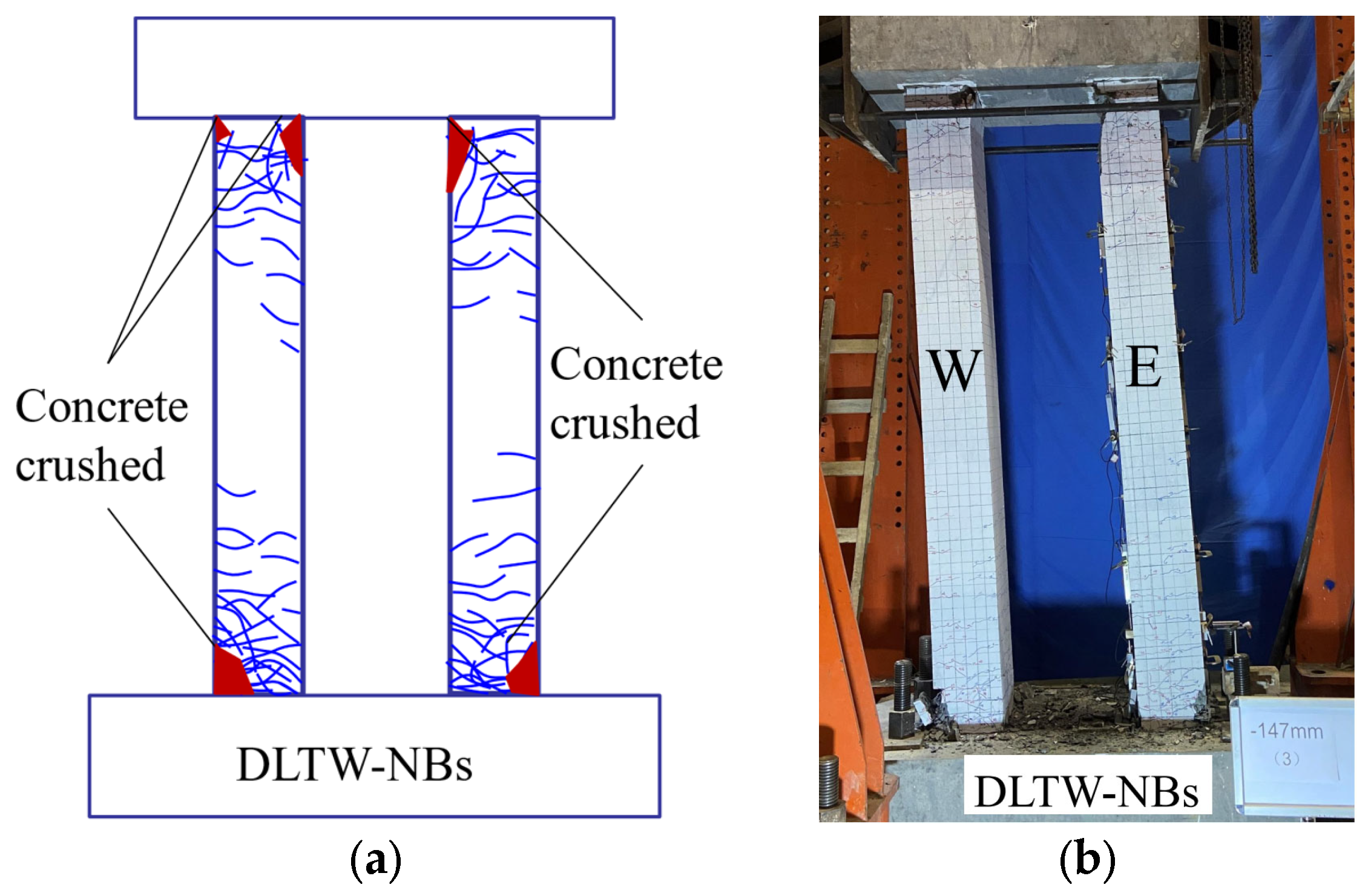






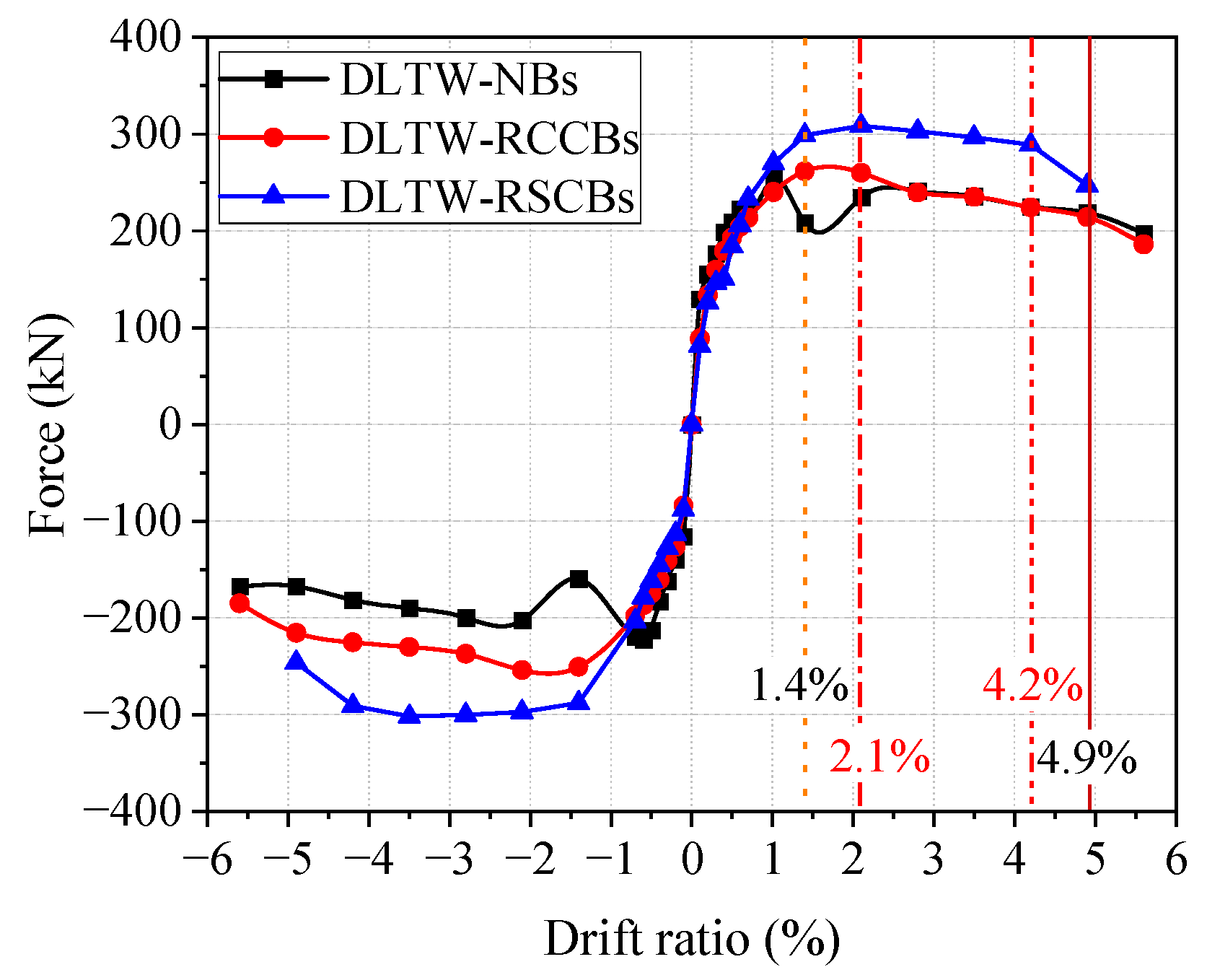
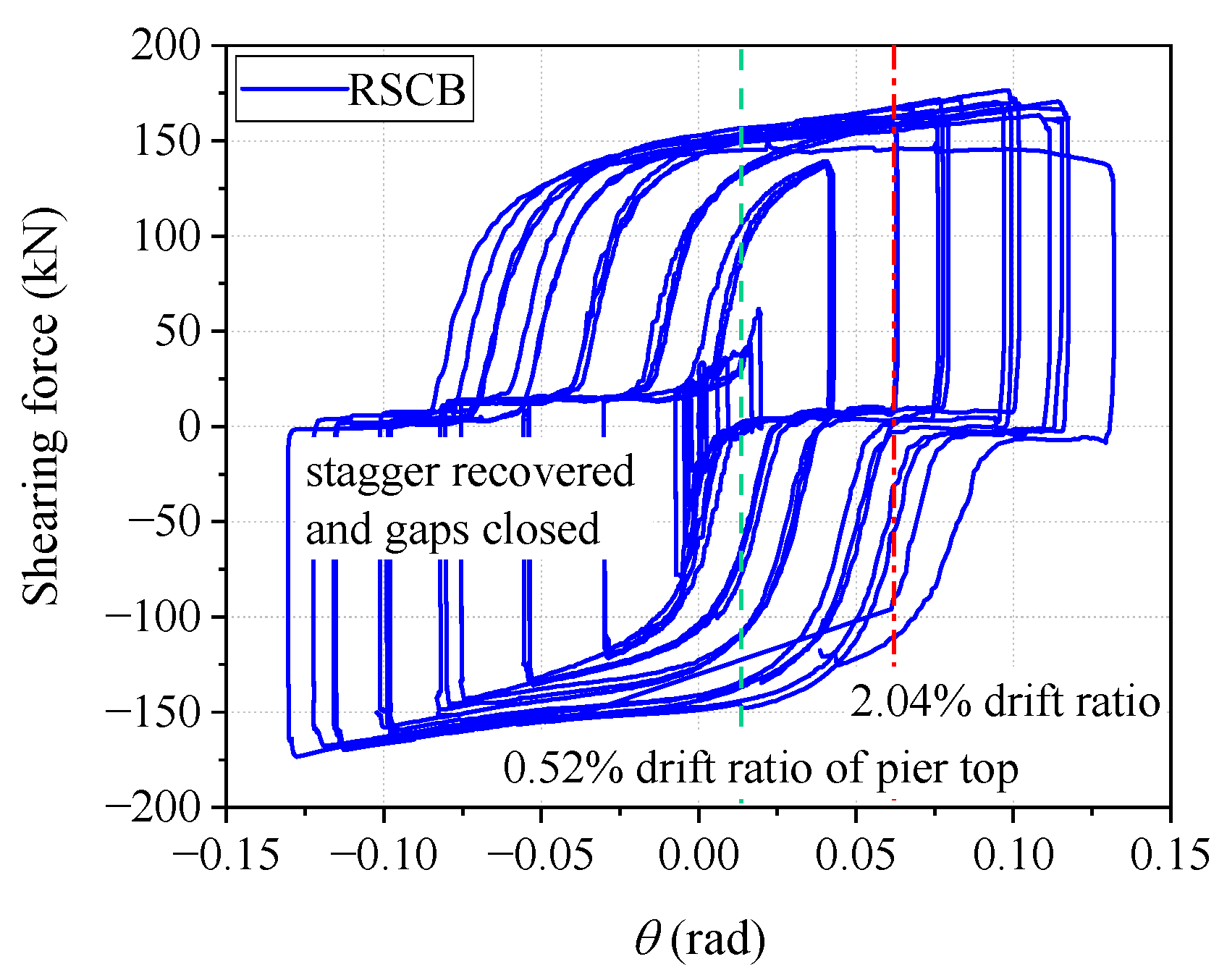


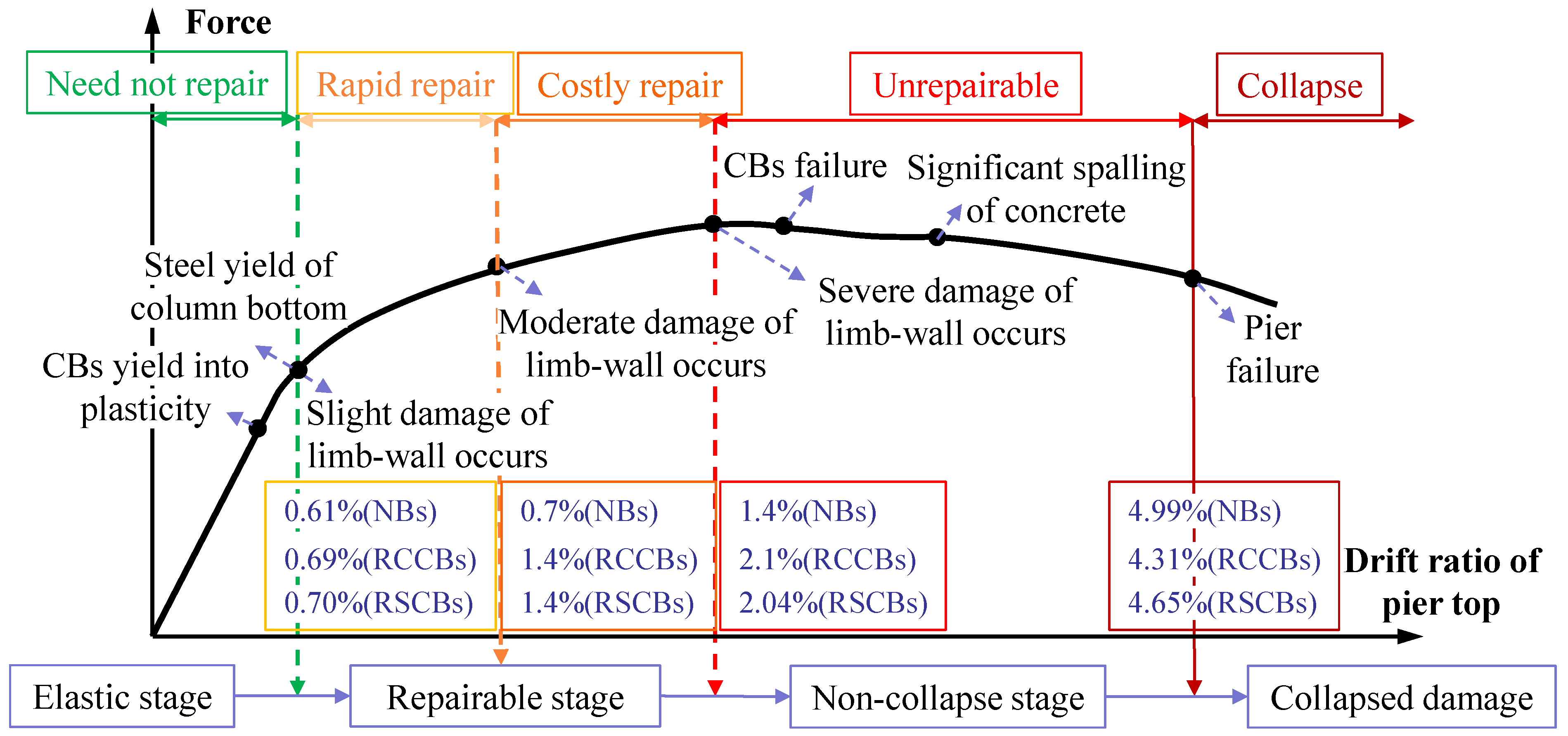
| Specimen | Connection Type of Limb-Wall Ends | Numbers of CBs | Limb-Wall Heights (mm) | Clear Distances Between Two Limb-Walls (mm) |
|---|---|---|---|---|
| DLTW-NBs | consolidation | 0 | 3000 | 600 |
| DLTW-RCCBs | consolidation | 2 | 3000 | 600 |
| DLTW-RSCBs | consolidation | 2 | 3000 | 600 |
| Longitudinal Reinforcement | Stirrup | |||||
|---|---|---|---|---|---|---|
| Type | Diameter (mm) | Reinforcement Ratio (%) | Type | Diameter (mm) | Spacing (mm) | Reinforcement Ratio (%) |
| HRB400 | 14 | 1.80 | HRB400 | 10 | 75/120 | 1.48/0.93 |
| Type of Beam | Section Shape | Cross Section of Energy-Dissipation Segment | Width-to-Thickness | Height-to-Thickness | Shear Capacity (kN) | |||
|---|---|---|---|---|---|---|---|---|
| Height (mm) | Width (mm) | Length (mm) | Thickness (mm) | |||||
| RCCBs | Rectangle | 180 | 110 | 600 | - | - | - | 145.22 |
| RSCBs | H-shaped | 120 | 80 | 200 | 5 | 8 | 22 | 146.35 |
| Type | Diameter or Thickness (mm) | Yielding Strength (MPa) | Ultimate Strength (MPa) | Elastic Modulus (GPa) | Elongation (%) |
|---|---|---|---|---|---|
| HRB400 | 16 | 443.5 | 621.3 | 172.8 | 18.68 |
| 14 | 422.5 | 607.5 | 194.5 | 19.35 | |
| 10 | 475.0 | 680.0 | 244.5 | 14.95 | |
| Q235 | 5 | 291.0 | 447.1 | 217.7 | 37.25 |
| Specimen | CB Yielding | Yield Point | Peak Point | Failure Point | Displacement Ductility μΔ | |||||||
|---|---|---|---|---|---|---|---|---|---|---|---|---|
| Δ /mm | Drift Ratio/% | Δy/mm | Drift Ratio/% | Fy/kN | Δm/mm | Drift Ratio/% | Fm/kN | Δu/mm | Drift Ratio/% | Fu/kN | ||
| DLTW-NBs | - | - | 18.3 | 0.61 | 215 | 30.5 | 1.02 | 254 | 149.9 | 4.99 | 216 | 8.19 |
| DLTW-RCCBs | 14.5 | 0.48 | 20.8 | 0.69 | 214 | 42.1 | 1.40 | 262 | 129.4 | 4.31 | 223 | 6.22 |
| DLTW-RSCBs | 15.7 | 0.52 | 21.1 | 0.70 | 233 | 62.7 | 2.09 | 309 | 139.5 | 4.65 | 262 | 6.61 |
| Number of RSCB | Residual Rotation of Rigid Segment End Plates φre/rad | Replacement Time/h | |
|---|---|---|---|
| Removal | Installation | ||
| RSCB-1 | 0.018 | 0.16 | 0.67 |
| RSCB-2 | 0.013 | 0.19 | |
Disclaimer/Publisher’s Note: The statements, opinions and data contained in all publications are solely those of the individual author(s) and contributor(s) and not of MDPI and/or the editor(s). MDPI and/or the editor(s) disclaim responsibility for any injury to people or property resulting from any ideas, methods, instructions or products referred to in the content. |
© 2023 by the authors. Licensee MDPI, Basel, Switzerland. This article is an open access article distributed under the terms and conditions of the Creative Commons Attribution (CC BY) license (https://creativecommons.org/licenses/by/4.0/).
Share and Cite
Guo, J.; Nie, L.; Su, J.; Sun, R. Experimental Study on an Innovative Double-Limb-Thin-Wall Bridge Pier with Longitudinal Replaceable Connecting Beams. Sustainability 2023, 15, 7486. https://doi.org/10.3390/su15097486
Guo J, Nie L, Su J, Sun R. Experimental Study on an Innovative Double-Limb-Thin-Wall Bridge Pier with Longitudinal Replaceable Connecting Beams. Sustainability. 2023; 15(9):7486. https://doi.org/10.3390/su15097486
Chicago/Turabian StyleGuo, Jin, Liwei Nie, Junsheng Su, and Ruojin Sun. 2023. "Experimental Study on an Innovative Double-Limb-Thin-Wall Bridge Pier with Longitudinal Replaceable Connecting Beams" Sustainability 15, no. 9: 7486. https://doi.org/10.3390/su15097486
APA StyleGuo, J., Nie, L., Su, J., & Sun, R. (2023). Experimental Study on an Innovative Double-Limb-Thin-Wall Bridge Pier with Longitudinal Replaceable Connecting Beams. Sustainability, 15(9), 7486. https://doi.org/10.3390/su15097486





